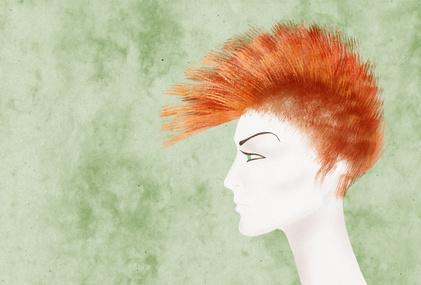Obviously you wouldn't purposely spend precious time and money to transform your hair color to a gorgeous shade of caramel or achieve perfect honey highlights only to ruin it the second you step out of the salon.
Unfortunately, many of the seemingly harmless aspects of your daily beauty routine — from showering to using your favorite hair products — may take a bigger toll on your dye job than you think. Here, all the things you should look out for to protect your hair color

Part 1
Water
While shampoo has long been deemed one of the main causes of premature fading, saturating strands with water alone can wreak havoc on dyed hair. "Water swells the hair fiber and lifts the cuticle, allowing water-soluble dye molecules in the matrix of your hair to escape," explains Diane Minar, a senior scientist at Nexxus New York Salon Care. And if your hair's cuticle is compromised (which is most likely the case if you color it, heat-style it, and so on), it's even more susceptible. "If your hair is damaged, it swells more easily when wet, making dye even more likely to get out," says Minar, who suggests coating dry strands with Nexxus New York Salon Care Color Assure Pre-Wash Primer, which prevents them from becoming oversaturated and dye molecules from being pulled out.
Heavy Styling Products
Although it seems counterintuitive, some hair oils and shine serums that you often reach for to soften your overprocessed strands could, over time, have the reverse effect. That's because these types of formulas often contain ingredients like heavy silicones, that coat the outer cuticle layer of hair. "Some types of silicones can build up on hair," explains Minar. "And when product builds up, it can also attract dirt and particulates from the air, all of which can cause color to look more dull even if it's actually intact in the hair fiber."
Physical Aggression
"Being rough on hair is really bad for color," says Kevin Mancuso, a hair stylist and trichologist in New York City and London. That means ripping through tangles with a brush or comb or constantly putting your hair up in tight ponytails and buns. "Eventually, it damages the cuticle," explains Mancuso. "Roughing up the hair is going to compromise the integrity of the structure itself, which means dye molecules will release out of strands and lead to your color fading much faster than it should." To help lessen the wear and tear, apply a light leave-in detangling or hydrating treatment daily on wet or dry strands to create better brush glide, and opt for softer, looser ponytails and buns.
Heat-Styling
Hot tools scorch strands — literally. And the more damaged the hair's cuticle layer is, the more susceptible it is to allowing water absorption to increase the loss of color and make your hair's hue appear dull. "Even though the color molecules may be inside strands, when hair is damaged, the surface isn't in great shape, so it's not laying flat down to reflect light," explains Mancuso. The goal: to keep strands smooth and align the cuticle for a natural shine benefit. To protect against the heat, try Nexxus New York Salon Care Oil Infinite Nourishing Hair Oil.
Skipping Trims
Think about it — the ends of your strands are the oldest, which means they've had to withstand the most heat damage and chemical processing. Over time, the ends become more and more damaged. This is why the dye molecules take differently to this section of hair ... not because of the split ends. The result: the bottom of your hair doesn't have the same fresh color as the rest of your hair. Mancuso recommends getting regular trims — every 10 to 12 weeks depending on the length and health of your hair — as well as using a treatment to help keep splits to a minimum.
Never Using Conditioner
Not only is using a daily rinse-out conditioner with hydrating styling products essential to keeping your color bright, using a hair mask, regardless of your texture, is crucial. "Once you strengthen your hair and get it as close to its virgin state as you can, the easier it's going to be to get the color that you want and the more choices you have in colors," says Mancuso. When hair is extremely damaged from drastic color changes (like that time you went from blonde to black and back to brunette), "it suddenly doesn't hold onto dye as well and can end up looking ombré even thought it's not," he adds.
UV Light
The sun's rays can lead to the break down of hair's matrix, which, as we now know, can exacerbate hair color fading along with a long list of other not-so-pretty side effects such as making hair dry, brittle, dull, and difficult to style. Unfortunately, hair products are yet to be laced with super effective sunscreen, so the best sun protection for hair is a wide-brimmed hat, says Mancuso. To help replenish lost moisture from over exposure to the sun's UV rays, use a lightweight leave-in conditioner daily. Celebrity stylist Lona Vigi recommends applying a hydrating mask to damp hair before wrapping it up into a low bun or loose braid. "This helps hide some strands from excessive UV exposure, especially the ends, which are the most prone to damage," she says.

View All Comments /Add Comment